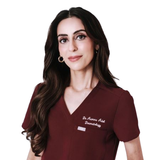
25th September, 2025
How Long Does it Take For Hair Growth Treatments to Work?
Written by: Dr Sumbel Khan | Reviewed by: Dr Aamna Adel

Written by
Dr Sumbel Khan
Junior doctor
Content writer/editor

Reviewed by
Dr Aamna Adel
Consultant dermatologist
Chief editor/writer
In This Article
When you’re battling hair loss, patience feels like a luxury you can’t afford. Unfortunately, overnight miracles are rare, if not non-existent, in the world of hair growth. So it’s important to do your research and find a solution that actually works.
Maybe it’s a hair serum, a shampoo, or medication - either way, there are a variety of hair growth strategies out there, you just need to find the right one for you.
Read on to find out about key hair growth strategies, how long they might take to show results, and what you can do to maximise them.
The Hair Growth Cycle
The two primary ways to enhance hair density are to stimulate new hair growth or to reduce the "hair fall" phase.
During the hair growth cycle, your hair follicles move through three main phases: anagen (growth), catagen (transition), and telogen (rest). Most effective treatments work by either extending the anagen phase, shortening the telogen phase, or reawakening dormant follicles to re-enter the anagen phase, also known as the growth phase.
Remember that each hair follicle has its own life cycle. A healthy anagen growth phase can last for years, but only a certain percentage of your hair is in this growth phase at any one time. Therefore, visible results across your whole scalp take time and persistence. We want you to invest your time in science-backed ingredients - so your hair grows from rhute to tip.
Here’s a science-backed guide to the expected timelines for some of the most common and effective hair growth treatments.

Medication Support: Minoxidil
Originally used as a blood pressure medication, Minoxidil is now a supremely effective topical treatment for hair loss. Its primary mechanism is vasodilation, aka the widening of blood vessels. This improves the flow of blood and nutrients to the hair follicle. It also helps to shorten the telogen resting phase, pushing follicles into the anagen growth phase sooner and prolonging their time in the anagen phase, which is associated with healthy hair growth.
You may notice an initial period of the “dread shed”, which can last for the first 2-8 weeks, during which hair can fall out. This can be a sign that follicles in the telogen phase are pushing out old hairs to make way for new, stronger ones. The first signs of new growth typically appear between 3 and 6 months. However, in some cases, it can take longer for initial regrowth. For optimal, meaningful results, you need to be consistent for at least 12 months. Be warned: if you stop using Minoxidil, the new hair growth gains will also likely reverse over several months.
Nutritional Support: Iron & Vitamin D
Have you ever suffered from anaemia, vitamin D deficiency or other nutritional deficiencies? Deficiencies in key nutrients are a common and reversible cause of hair shedding, a condition known as Telogen Effluvium. Let’s review some common deficiencies and their impact on hair health.
-
Iron: This mineral is crucial for producing haemoglobin, which carries oxygen for the growth and repair of cells, including those that build hair follicles! Low iron stores are a well-documented cause of fatigue, nail changes and hair loss.
-
Vitamin D: This glorious vitamin we receive from the sun plays a role in creating new follicles and kickstarting new anagen growth cycles. Vitamin D receptors are highly expressed in the skin and hair follicles, indicating their significant role in regulating the hair cycle. Many people in the United Kingdom are deficient in Vitamin D due to our lack of sunshine! For this reason, following NHS guidelines, it is recommended that everyone in the UK consider taking a daily vitamin D supplement during the autumn and winter months. And remember, when the sun returns - enjoy it by using SPF skin and scalp protection from those UV rays!
Your doctor may choose to do some of these tests if you present with hair loss, amongst other tests. If you have a diagnosed deficiency, it can take 2-3 months of supplementation under a doctor’s guidance to restore your body's levels. Following this, you can expect to see a reduction in shedding and early signs of regrowth within 3 to 6 months - as follicles recover and re-enter a healthy growth cycle.
DHT Hormone Blockers
Androgenetic alopecia, also known as male pattern baldness, is driven by dihydrotestosterone (DHT), a hormone that shrinks hair follicles in certain individuals. Treatments for this type of ‘hormonal hair loss’ aim to block the enzyme 5α-reductase, which converts testosterone to DHT. Let’s look at some common agents used for hair growth.
-
Finasteride: A well-known prescription option originally used for prostate issues that effectively blocks DHT. However, finasteride is definitely not suitable for everyone; so results may vary!
-
Pumpkin Seed Oil: For those seeking a botanical alternative, pumpkin seed oil has shown promising results, though not nearly as robustly tested as minoxidil or finasteride. The evidence is still emerging, but it is encouraging. A key 2014 study found that men who took pumpkin seed oil for 24 weeks saw a 40% increase in mean hair count, compared to a 10% increase in the placebo group. Based on the primary study, you should commit to using pumpkin seed oil for at least 6 months to gauge its effectiveness.
Low-Level Laser Therapy (LLLT)
LLLT uses specific wavelengths of red light to energise the cells within the hair follicle. The light is thought to be absorbed by mitochondria, the "powerhouses" of our cells, which increases cellular energy production.
This can stimulate follicles to enter and remain in the anagen growth phase. Using an LLLT device as directed (typically every other day), initial changes, such as reduced shedding, can be observed in 2-3 months. More visible improvements in density and thickness typically take 3 to 6 months.

Microneedling & Dermastamping
Microneedling and dermastamping techniques involve using a device with fine needles to create tiny, controlled micro-injuries on the scalp. This process activates the body’s natural wound-healing response, which releases growth factors that can stimulate dormant (telogen) hair follicles. Microneedling is also known to significantly enhance the absorption of topical treatments like Minoxidil.
One pivotal study demonstrated that using microneedling with Minoxidil produced significantly superior growth results compared to Minoxidil alone over a 12-week period. When used alone, visible results can take 3 to 4 months.
Important note: Please consult a professional to ensure you are using a hygienic and well-informed technique. Improper use or unhygienic equipment can lead to infection or damage to the scalp, creating a recipe for disaster.
Advanced Topical Ingredients
In addition to the well-known treatments, several active ingredients in modern serums work to create an optimal scalp environment for growth. These might be some of the best ingredients for hair growth - and ones you should look for in your next hair serum.
-
Caffeine: Topical caffeine has demonstrated powerful effects directly on the hair follicle. An influential study done in labs found that caffeine helped counteract the hair growth-suppressing effects of testosterone on the hair follicle. It stimulates cell energy and promotes the proliferation of the cells responsible for building the hair shaft, leading to an elongated hair shaft and a longer anagen phase.
-
Peptides: Copper peptides have been shown to reduce inflammatory signals in the scalp while stimulating the production of collagen and elastin, both crucial components for anchoring the hair follicle firmly in the skin. This creates a more robust foundation for healthy hair.
-
Botanical Stem Cell Extracts: Hair follicles are highly vulnerable to damage from stress caused by UV radiation (looking at you sun worshippers), pollution, and internal metabolic processes. Stem cell extracts, such as those from the rare Swiss apple Uttwiler Spätlauber, provide a concentrated dose of antioxidants. Research has shown these extracts can protect follicular cells from premature ageing and UV-induced stress, thereby preserving follicle function over time. They act as a shield, defending against the environmental aggressors above that can disrupt the hair growth cycle.
In Conclusion…
All of these ingredients begin improving scalp health from the first use. However, their visible impact on hair density is progressive and happens over time. When used consistently as part of a broader routine, you should use it for at least 6 months before expecting to see results.
For more information on the latest in hair health and the science behind recent trends, check out our blog.
References
- Hoover, E., Alhajj, M., & Flores, J. L. (2024). Physiology, Hair. In StatPearls. StatPearls Publishing.
- Rossi A, Cantisani C, Melis L, Iorio A, Scali E, Calvieri S. Minoxidil use in dermatology, side effects and recent patents. Recent Pat Inflamm Allergy Drug Discov. 2012 May;6(2):130-6. doi: 10.2174/187221312800166859. PMID: 22409453.
- Park, S. Y., Na, S. Y., Kim, J. H., Cho, S., & Lee, J. H. (2013). Iron plays a certain role in patterned hair loss. Journal of Korean medical science, 28(6), 934–938.
- Saini, K., & Mysore, V. (2021). Role of vitamin D in hair loss: A short review. Journal of cosmetic dermatology, 20(11), 3407–3414.
- Cho, Y. H., Lee, S. Y., Jeong, D. W., Choi, E. J., Kim, Y. J., Lee, J. G., Yi, Y. H., & Cha, H. S. (2014). Effect of pumpkin seed oil on hair growth in men with androgenetic alopecia: a randomized, double-blind, placebo-controlled trial. Evidence-based complementary and alternative medicine : eCAM, 2014, 549721.
- Avci, P., Gupta, G. K., Clark, J., Wikonkal, N., & Hamblin, M. R. (2014). Low-level laser (light) therapy (LLLT) for treatment of hair loss. Lasers in surgery and medicine, 46(2), 144–151.
- Fertig, R. M., Gamret, A. C., Cervantes, J., & Tosti, A. (2018). Microneedling for the treatment of hair loss? Journal of the European Academy of Dermatology and Venereology, 32(4), 564-569.
- Dhurat, R., Sukesh, M., Avhad, G., Dandale, A., Pal, A., & Pund, P. (2013). A randomized evaluator blinded study of effect of microneedling in androgenetic alopecia: a pilot study. International journal of trichology, 5(1), 6–11.
- Fischer, T. W., Hipler, U. C., & Elsner, P. (2007). Effect of caffeine and testosterone on the proliferation of human hair follicles in vitro. International journal of dermatology, 46(1), 27–35.
- Choi, S., Lee, S., Kim, Y., Lee, T. R., & Lee, J. (2022). Copper-GHK, a Popular Cosmeceutical, Promotes Wound Healing by Activating the JAK/STAT Signaling Pathway. International journal of molecular sciences, 23(20), 12154.
- Schmid, D., Schürch, C., Belser, E., & Zülli, F. (2008). Plant Stem Cell Extract for Longevity of Skin and Hair. SOFW Journal, 134(5), 30-35.